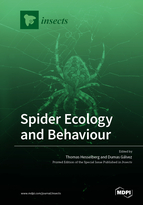Spider Ecology and Behaviour
A special issue of Insects (ISSN 2075-4450). This special issue belongs to the section "Other Arthropods and General Topics".
Deadline for manuscript submissions: closed (31 October 2022) | Viewed by 27100
Special Issue Editors
Interests: spider ecology and behaviour; construction behaviour; subterranean biology; comparative biomechanics; biomimetics
Special Issue Information
Dear Colleagues,
Spiders, while to some extent remaining the overlooked cousins of the far more diverse insects, have been the subject of increasing research efforts in recent years. As they are only large arthropod group that uses silk throughout their life, much effort has been focused on the interactions between ecology, silk, and foraging behavior, but it is also becoming clear that spiders can more generally act as model organisms for studies on sexual selection, invertebrate cognition, and animal communication and signaling, as well as their potential role in biological control. Similarly, new promising research directions are being developed exploring plant–spider and spider–microbe interactions.
This Special Issue will broadly address studies on Spider Ecology and Behavior across all relevant disciplines, including applied areas such as their conservation and role as bioindicators. In this context, submissions in the form of reviews/mini reviews, opinions, and original basic or applied research are welcome.
Dr. Thomas Hesselberg
Dr. Dumas Gálvez
Guest Editors
Manuscript Submission Information
Manuscripts should be submitted online at www.mdpi.com by registering and logging in to this website. Once you are registered, click here to go to the submission form. Manuscripts can be submitted until the deadline. All submissions that pass pre-check are peer-reviewed. Accepted papers will be published continuously in the journal (as soon as accepted) and will be listed together on the special issue website. Research articles, review articles as well as short communications are invited. For planned papers, a title and short abstract (about 100 words) can be sent to the Editorial Office for announcement on this website.
Submitted manuscripts should not have been published previously, nor be under consideration for publication elsewhere (except conference proceedings papers). All manuscripts are thoroughly refereed through a single-blind peer-review process. A guide for authors and other relevant information for submission of manuscripts is available on the Instructions for Authors page. Insects is an international peer-reviewed open access monthly journal published by MDPI.
Please visit the Instructions for Authors page before submitting a manuscript. The Article Processing Charge (APC) for publication in this open access journal is 2600 CHF (Swiss Francs). Submitted papers should be well formatted and use good English. Authors may use MDPI's English editing service prior to publication or during author revisions.
Keywords
- behavioral flexibility
- biological control
- community structure
- foraging behavior
- mating behavior
- plant–spider interactions
- spider conservation
- spider cognition
- web-building behavior








